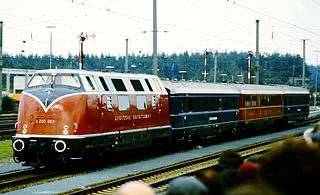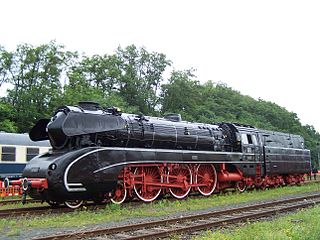
The Deutsche Bundesbahn or DB (German Federal Railway) was formed as the state railway of the newly established Federal Republic of Germany (FRG) on 7 September 1949 as a successor of the Deutsche Reichsbahn-Gesellschaft (DRG). The DB remained the state railway of West Germany until after German reunification, when it was merged with the former East German Deutsche Reichsbahn (DR) to form Deutsche Bahn, which came into existence on 1 January 1994.

The Deutsche Reichsbahn-Gesellschaft's BR 01 steam locomotives were the first standardised (Einheitsdampflokomotive) steam express passenger locomotives built by the unified German railway system. They were of 4-6-2 "Pacific" wheel arrangement in the Whyte notation, or 2′C1′ h2 in the UIC classification. The idea of standardisation was that it would reduce maintenance costs; i.e. if a BR 01 whose engine shop was in, say, Berlin broke down in Dresden, instead of having to ship the necessary part from Berlin and take the locomotive out of service, a part from the Dresden shop could be used as all of the engines, parts, and workings were exactly the same and produced nationwide. Thus it was a "standard" product for engine shops.

DB Class V 200 was the first series production diesel-hydraulic express locomotive of the German Deutsche Bundesbahn and – as Am 4/4 – of the SBB-CFF-FFS in Switzerland.

The Nuremberg Transport Museum is based in Nuremberg, Germany, and consists of the Deutsche Bahn's own DB Museum and the Museum of Communications. It also has two satellite museums at Koblenz-Lützel and Halle. The Nuremberg Transport Museum is one of the oldest technical history museums in Europe.

The Darmstadt-Kranichstein Railway Museum is a railway museum in the German city of Darmstadt. It is also the largest railway museum in the state of Hesse.

The German DRG Class 02 engines were standard (Einheitslokomotiven) express train locomotives with the Deutsche Reichsbahn-Gesellschaft. Number 02 001 was the first Einheitsdampflokomotive in the DRG to be completed.

German Kleinlokomotiven like the DRG Kö II were developed as locomotives with a low weight and driving power for light shunting duties. There were two classes, based on engine power. The Class II were engines which developed more than 40 HP.

The Prussian T 18 was the last class of tank locomotives developed for the Prussian state railways. They were originally intended for services on the island of Rügen as replacements for Class T 12 and T 10 engines. They emerged when a class of locomotive was conceived in 1912 that was to handle express and passenger trains in border areas or in shuttle services on short routes. A tank engine design with symmetrical running gear was envisaged because, unlike a tender locomotive, it could run equally fast forwards and backwards and could be operated on return journeys without having to be turned on a turntable. Its power and top speed were to be the same as those of the P 8. Robert Garbe designed this 4-6-4 (2′C2′) tank locomotive for 100 km/h with a 17-ton axle load and contracted the Vulkan Werke in Stettin to build it. It was given the designation T 18.

The steam locomotives of DB Class 10 were express locomotives with the Deutsche Bundesbahn in Germany after the Second World War. They were nicknamed 'Black Swans' as a result of their elegant shape.

The DR Class 01.5 was the designation given by the Deutsche Reichsbahn in East Germany to express train locomotives that were 'reconstructed' from those of the pre-war DRG Class 01.

An Ausbesserungswerk is a railway facility in German-speaking countries, the primary function of which is the repair of railway vehicles or their components. It is thus equivalent to a 'repair shop' or 'works'. It is also referred to as a Centralwerkstatt or Zentralwerkstatt or Hauptwerkstatt. During the Deutsche Reichsbahn-Gesellschaft (DRG) period between the two world wars as well as the period of the Deutsche Reichsbahn in East Germany these facilities were called Reichsbahnausbesserungswerke.

A Bahnbetriebswerk is a German railway depot where the maintenance of locomotives and other rolling stock is carried out. It is roughly equivalent to a locomotive shed, running shed or motive power depot. These were of great importance during the steam locomotive era to ensure the smooth running of locomotive-hauled services. Bahnbetriebswerke had a large number of facilities in order to be able to carry out their various maintenance tasks. As a result, they needed a lot of staff and were often the largest employers in the area.

The DR 130 family of locomotives comprises the DR Class 130, DR Class 131, DR Class 132 and DR Class 142, in USSR locomotive called TE109 and TE129.

Andermatt railway station is a railway station and junction on the metre gauge Furka Oberalp Bahn (FO), serving the town and municipality of Andermatt, in the canton of Uri, Switzerland. The station is connected, via the Furka Pass, with Brig and Visp in the canton of Valais, and, via the Oberalp Pass, with the western terminus of the Rhaetian Railway at Disentis/Mustér, in the canton of Graubünden. There is also a short branch line, the Schöllenenbahn, between Andermatt and Göschenen, at the northern end of the standard gauge Gotthard Rail Tunnel.

Bad Schandau station is a minor junction station in Bad Schandau in the German state of Saxony. The station is located on the south bank on the Elbe on the Děčín–Dresden-Neustadt railway and it is also the terminus of the Bautzen–Bad Schandau railway. The town is located on the north side of the river and is connected to the station by a ferry and a road bridge.

Pirna station is the largest railway station in the town of Pirna in the German state of Saxony. The station is integrated into the network of the Dresden S-Bahn. It is also the starting point of a Regionalbahn service and a Regional-Express stop.

The DR Class V 100, redesignated the Class 110 in 1970, was a four-axled diesel locomotive for medium duties operated by the Deutsche Reichsbahn of East Germany. Locomotives of the type were also supplied to railways in China and Czechoslovakia and to various industrial operators.

Lauda station is a junction station in the town of Lauda-Königshofen in the German state of Baden-Württemberg, where the northern section of the Tauber Valley Railway branches from the Franconia Railway. Lauda station is classified by Deutsche Bahn as a category 5 station.

Greiz station is located in the town of Greiz in the German state of Thuringia. It is on the Gera Süd–Weischlitz railway, which is still in operation, and the Neumark–Greiz railway, which has been suspended since 1999, branches off there.





















